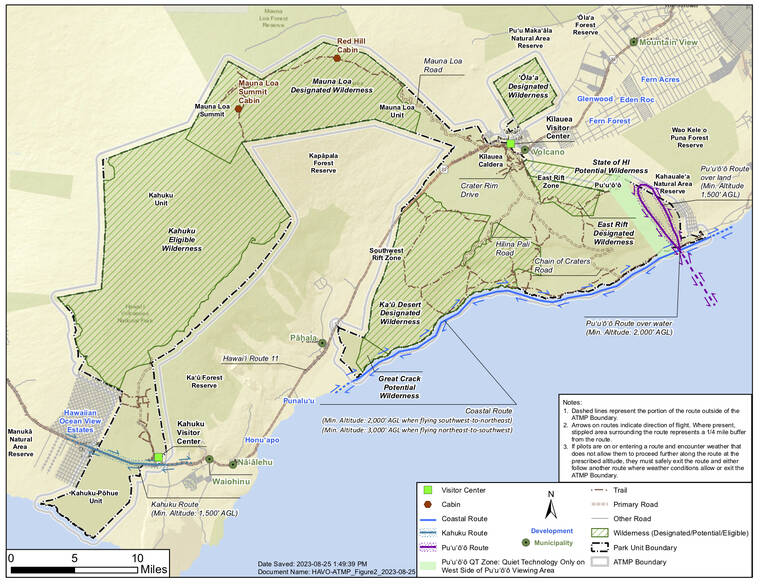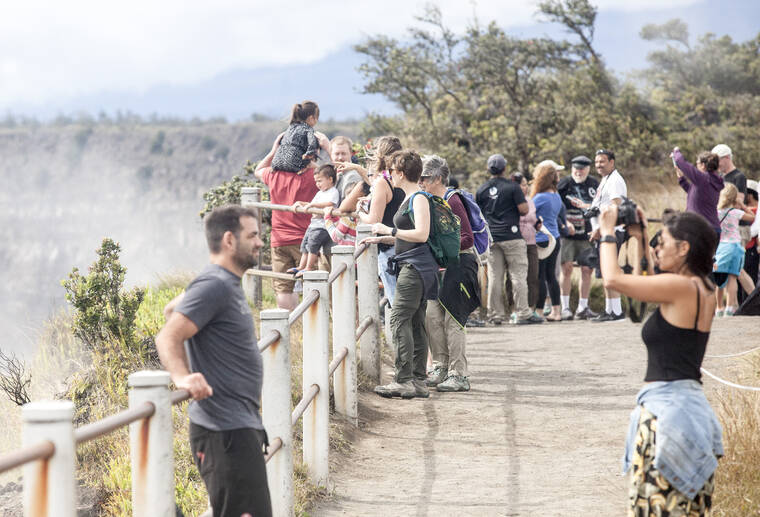HVNP air tours limited: New management plan puts substantial restrictions on overflights

A map of HVNP delineating the three permitted air tour routes.

In this Tribune-Herald file photo, tourists look at the Kilauea caldera from the Crater Rim Trail near the steam vents in Hawaii Volcanoes National Park. A new Air Tour Management Plan substantially restricts the number of helicopter tours over the park in an effort to reduce noise and protect the natural environment.
Air tours above Hawaii Volcanoes Natural Park will be cut by nearly 90% under a long-awaited new Air Tour Management Plan.
Air tours above Hawaii Volcanoes Natural Park will be cut by nearly 90% under a long-awaited new Air Tour Management Plan.
The National Park Service and Federal Aviation Administration on Wednesday completed the plan, which was required to be developed after a federal appeals judge determined in 2020 the two agencies were not in compliance with the Air Tour Management Act of 2000, following a lawsuit by a community group.
ADVERTISING
That lawsuit, filed in 2018 by Hawaii Island Coalition Malama Pono, complained of extensive helicopter noise over Puna, particularly near the national park. In order to reduce the noise, the ATMP imposes sweeping measures that would drastically restrict air tours.
HNVP estimates that more than 11,300 air tours above the park take place annually. Under the ATMP, those flights would be slashed to only 1,548, with operators limited to only a handful of tours allowed per year.
The plan identifies five permitted air tour operators and locks them into rigid maximum activity limits. Blue Hawaiian Helicopters, the most prolific air tour operator on the island, is limited to only four tours per day, or 1,176 per year, and only one flight on a given route at a time.
Other operators are even more restricted: Safari Helicopter Tours is limited to 185 flights per year, Sunshine Helicopters to 109 per year and Paradise Helicopters to 77 per year. All three are limited to a single flight per day. The last operator, Mokulele Airlines, is limited to a single flight per year.
According to the plan, those limits were determined based on each operator’s average reported total flights per year between 2017 and 2019.
Only three routes are now permitted under the ATMP, including a bidirectional route along the Puna coast within the park boundaries, a bidirectional route along Highway 11 within the park’s Kahuku Unit (between Hawaiian Ocean View Estates and Waiohinu), and a loop circling above Pu‘u O‘o.
Each of these routes includes additional rules — for example, flights must maintain minimum altitudes of 1,500 feet while above ground, 2,000 feet while above the sea, and 3,000 feet while traveling southwest on the coastal route. Flights on the coastal route also are required to maintain at least 2,000 feet of lateral distance from the shore at all times.
The ATMP also prohibits “hovering, loitering, and/or circling” on any of the routes save for the Pu‘u O‘o loop, where it is permitted for no more than one minute at a time and up to five minutes total per tour. Pilots are required to radio in whenever they enter or leave any route.
Additionally, the ATMP vastly reduces the days and hours that air tours are permissible: a four-hour window between 10 a.m. and 2 p.m. on Mondays, Tuesdays, Thursdays, Fridays and Saturdays. Sundays are designated “no-fly” days, as are Feb. 9 and Dec. 19 — in honor of the birth dates of Ruth Ke‘elikolani and Bernice Pauahi Bishop — and six traditional Hawaiian holidays: the beginning and end of Makahiki in the autumn and late winter, the Lahaina Noons in May and July, and the summer and winter solstices.
Because those six holidays follow the lunar calendar and don’t fall on set dates, the dates will be determined year-by-year through outreach with Native Hawaiian organizations, according to the ATMP.
Operators using “quiet technology aircraft” may be permitted to conduct tours between 9 a.m. and 5 p.m. on permitted days, as well as Wednesdays. The ATMP does not, however, define “quiet technology,” and states that such determinations will also be made case-by-case based on the FAA’s noise certification standards.
The plan includes several pages justifying the measures taken. It notes that helicopter noise can negatively affect the behaviors of native and endangered birds, and that the ambient natural noise of the park is very low, which makes aircraft noise very noticeable. The routes were also selected to shift air traffic away from key bird habitats.
Naturally, such extensive restrictions have left air tour operators concerned about the future.
Cal Dorn, CEO of Paradise Helicopters, called the plan “a little bit ludicrous” and said it would be untenable to maintain.
“It’s going to impact our livelihood, definitely,” Dorn said, noting that the routes delineated in the plan do not go anywhere near any landmarks that visitors want to see.
“There’s no lava right now, so the park isn’t in huge demand right now,” Dorn said. “If lava from the next eruption is outside the park, then it’ll be fine for us. If it’s inside the park, then we’re going to have trouble.”
Dorn said the plan seems to have been developed without consulting any air operators. For example, he noted that while helicopters at higher altitudes are indeed quieter, they project noise downward in a cone shape, meaning that noise from higher-altitude craft is audible in a wider area. He suggested that for remote routes like the coastal one, higher minimum altitudes might do the opposite of the intended effect.
“We’re sympathetic to noise complaints,” Dorn said. “We try to show people the island with the least impact possible.”
Dorn said that the loss of air tour operators could have unintended side effects. He said his business and others provided air assistance following various natural disasters including the 2018 Kilauea eruption and the Lahaina wildfire this year. If air tour companies go out of business and sell their aircraft, he said, other companies will not necessarily spring up to replace them.
Some other helicopter operators echoed Dorn’s concerns during a public comment period regarding the ATMP earlier this year. Airbus Helicopters argued that cutting flights so aggressively should not be done without a proper economic impact study.
“We are concerned that limiting the number of (flights) will not allow for a profitable business nor the realistic prospect of becoming profitable, if demand for air tours increases,” wrote Treg Manning, Airbus’ vice president for sales and marketing.
But while pilots and tour operators had their concerns, they were the minority of the public comments submitted this year. More than 5,000 people submitted a form letter complaining that “commercial air tours have been shattering the natural sounds that visitors come to enjoy.”
Bob Ernst, founding board member of Hawaii Island Coalition Malama Pono, or HICoP, said he was disappointed that the plan doesn’t go even further. Those thousands of form letters, he said, were specifically advocating for no air tours over the park at all.
“We’ve been advocating for years that there should be no tour helicopters over HVNP,” Ernst said. “They told us to comment on the plan, so why didn’t they listen to the comments?”
Ernst said that the state’s management of the entire issue has been disappointing, saying it’s been “24 years and counting” that the state has been out of compliance with the Air Tour Management Act of 2000.
“I think what it boils down to is, money talks,” Ernst said. “It’s been a very profitable industry, they’ve been happy to spread their wealth around. … But it didn’t have to be this way. They could’ve been good neighbors.”
U.S. Rep. Ed Case, who has been outspoken about the need for greater air tour regulation, said in a written statement Thursday the ATMP is “a great improvement over the devastation to the park, its wildlife and spirit, and to surrounding communities, from current virtually unregulated operations.”
“I sincerely hope that the air tour companies will now finally appreciate the severe disruption their operations cause to communities across Hawaii Island and our state and to other special places like Waipio Valley, and voluntarily limit their activities to curtail disruption before we do it for them,” wrote Case.
“The ATMP is more than 20 years in the making,” HVNP Superintendent Rhonda Loh said in a statement. “It significantly reduces the number of low-flying air tours over the park to protect the natural and cultural resources, the wilderness character and general visitor experience. We deeply appreciate everyone’s input throughout this long process with us.”
Air tour operators must comply with the terms of the ATMP by mid-June 2024, 180 days after the publication of the plan.
Email Michael Brestovansky at mbrestovansky@hawaiitribune-herald.com.


